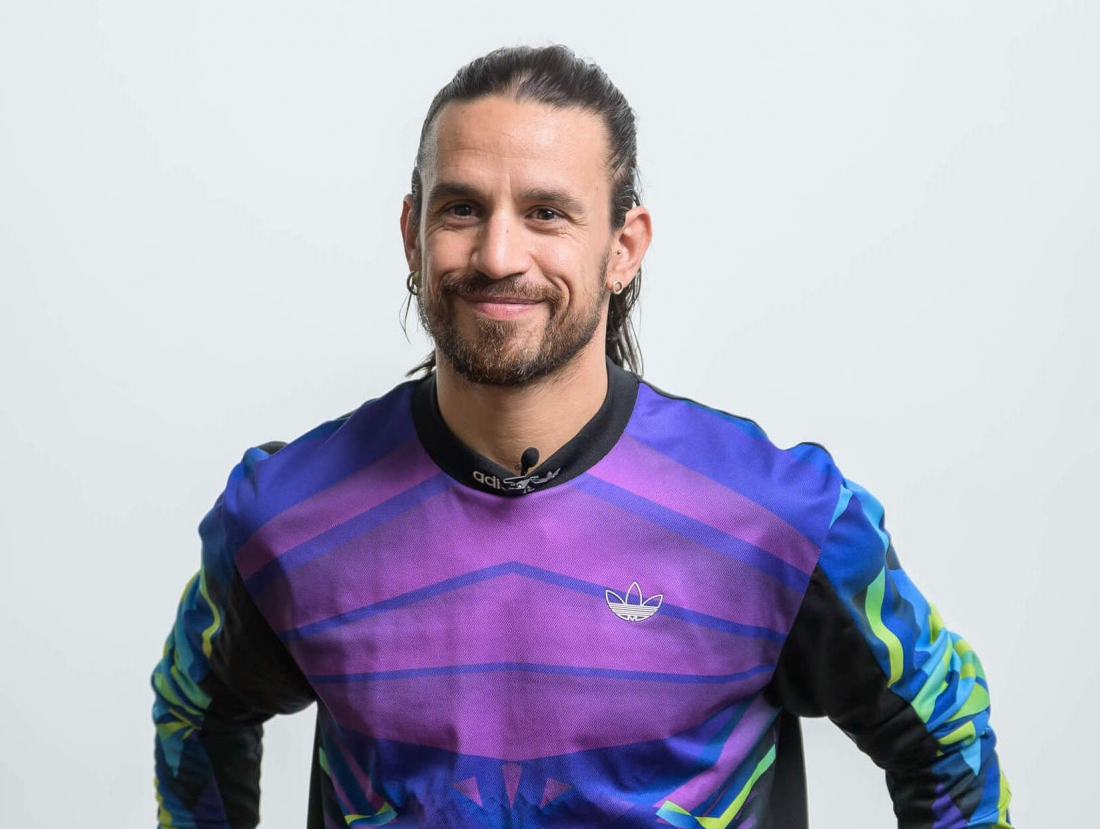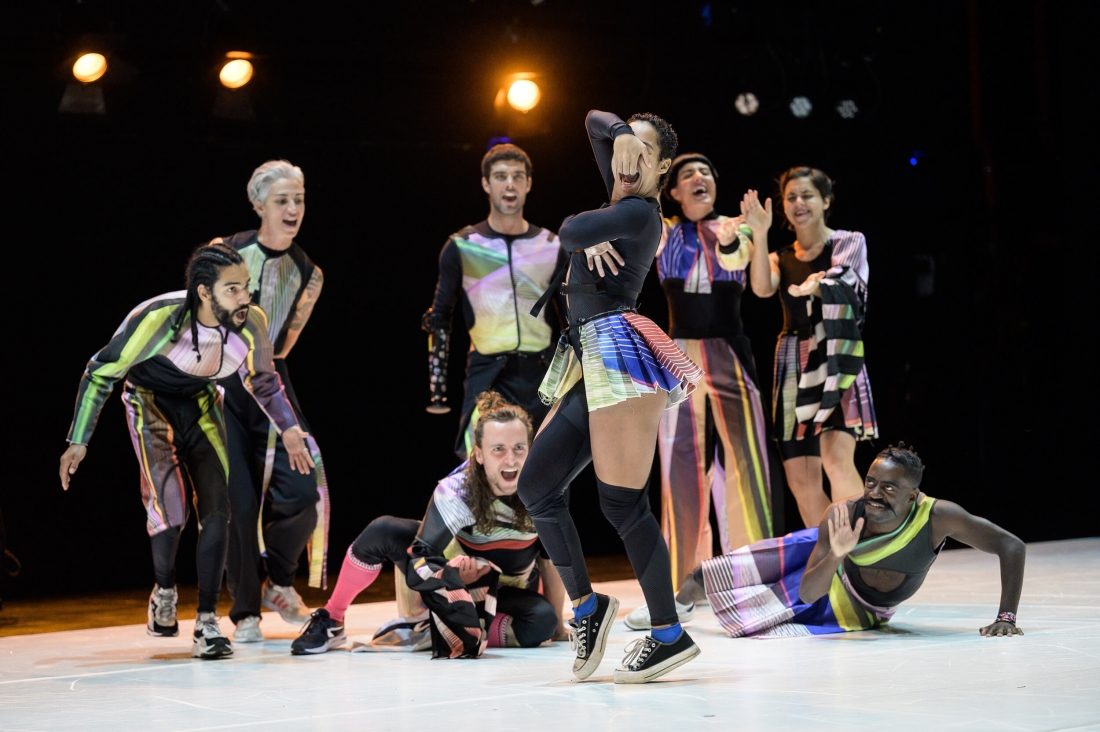Interview
Marco da Silva Ferreira
October
2022
Tue
11
In his new work, Marco da Silva Ferreira wanders between the past and the present, footwork and folklore. In C A R C A Ç A [C A R C A S S], the performers dance about the idea of individual identity and community, cultural crystallization and the future. We talked to the choreographer about the premiere, on October 21st and 22nd, at Teatro Rivoli.
Where does this idea of "carcass" come from in the creative process of the piece? Could it be related to an idea of “body as object”, which mutates and absorbs different layers throughout time?
“Carcass” is a word which came up during the rehearsals for another process and it seemed to me like a good metaphor, a good adjective for a creation. Above all because a carcass is the remaining shape from something which is no longer alive. So, there is a very direct link to the past, a direct link to a shape which allows us to make illations. Seeing the carcass of a dinosaur allows us to imagine its skin. We can acknowledge that information or simply make it fictional. Footwork was the basis of my work for this piece. And I wanted to combine a sort of footwork - clubbing and contemporary street dances - which is very close to me with the vertical body work of what they say it’s my heritage: the European folklore. In this meeting, I want to provoke thoughts about a collective identity’s building process: “Yes, this is us; this represents us; we identify ourselves with it”. C A R C A Ç A [C A R C A S S] is the quest for the shape of things, somewhere between the past and the present.
On the construction of a collective identity, how pivotal are these group dances in establishing a dialogue between different generations, between what was left behind and what was recovered?
The dances approached in C A R C A Ç A emerged in social environments. So, they absorb a lot of what is the socio-economic, political, ethnic context. These dances reflect the realities of communities: their people, their desires, their fears. Supposedly, folklore is also a reflex of that. But, at a certain point, these dances were taken over by an authoritarian government that began to restrict what could be said, held, dressed, sung. Folklore was no longer representing anyone. It only conveyed an international idea of what Portugal could be; of what people from Trás-os-Montes or Alentejo could be. A process of cultural crystallization took place. And there was nothing organic or real about it. It wasn’t built by that community. There was a certain paternalism of someone hierarchically superior who stated: “you are this!” This crystallization made it possible to effectively stop representing those communities. This piece intends to provoke a meeting between these contemporary social dances, which indeed build communities and define groups of people, today, in a given territory. They indeed create a collective identity. We are all born within a time and space. We can never separate ourselves from a legacy, from the burden that comes from the past, which we continue to carry and be responsible for what we want to preserve, transform or even forget about. This piece is about collective responsibility. How is the identity of a community built? What is it based on? What is the relationship that this community has with its past? How does it relate to your desires for the future? What do you want to forget and what do you want to rebuild? It's about the power of this group, now, to decide about what they received.
You are collaborating with ten performers and two musicians with very different backgrounds. How do their backgrounds intersect with the presence of folklore?
This is a very heterogeneous group, but the performers were already familiar with each other. Working together strengthened their ties and common points of interest. It is a cast with similar ages, similar socio-political contexts, who share desires about who we are today: we, Portugal; we, Portuguese; we, Europeans; about the borders that are being created or blurred. We all agree in these aspects, so it was easy to find that sense of community within the group. As for musicians, Luís Pestana comes from electronic music. He has an amazing album entitled Rosa Pano, which serves as the basis for this work, relying heavily on the digital but keeping a traditional atmosphere. Synthesizers intersect with human voices; and voices intersect with bagpipes and the most traditional Portuguese wind instruments. João Pais Filipe has a percussive quality forming a perfect triangle between fast rhythms (which are related to trance and techno), but at the same time an instrument that easily enters the lexicon of American post-classical music (like Steve Reich, for example), and the percussion of the fanfares, of the philharmonic bands, which can easily be extracted from the drum kit.
Where does this idea of "carcass" come from in the creative process of the piece? Could it be related to an idea of “body as object”, which mutates and absorbs different layers throughout time?
“Carcass” is a word which came up during the rehearsals for another process and it seemed to me like a good metaphor, a good adjective for a creation. Above all because a carcass is the remaining shape from something which is no longer alive. So, there is a very direct link to the past, a direct link to a shape which allows us to make illations. Seeing the carcass of a dinosaur allows us to imagine its skin. We can acknowledge that information or simply make it fictional. Footwork was the basis of my work for this piece. And I wanted to combine a sort of footwork - clubbing and contemporary street dances - which is very close to me with the vertical body work of what they say it’s my heritage: the European folklore. In this meeting, I want to provoke thoughts about a collective identity’s building process: “Yes, this is us; this represents us; we identify ourselves with it”. C A R C A Ç A [C A R C A S S] is the quest for the shape of things, somewhere between the past and the present.
On the construction of a collective identity, how pivotal are these group dances in establishing a dialogue between different generations, between what was left behind and what was recovered?
The dances approached in C A R C A Ç A emerged in social environments. So, they absorb a lot of what is the socio-economic, political, ethnic context. These dances reflect the realities of communities: their people, their desires, their fears. Supposedly, folklore is also a reflex of that. But, at a certain point, these dances were taken over by an authoritarian government that began to restrict what could be said, held, dressed, sung. Folklore was no longer representing anyone. It only conveyed an international idea of what Portugal could be; of what people from Trás-os-Montes or Alentejo could be. A process of cultural crystallization took place. And there was nothing organic or real about it. It wasn’t built by that community. There was a certain paternalism of someone hierarchically superior who stated: “you are this!” This crystallization made it possible to effectively stop representing those communities. This piece intends to provoke a meeting between these contemporary social dances, which indeed build communities and define groups of people, today, in a given territory. They indeed create a collective identity. We are all born within a time and space. We can never separate ourselves from a legacy, from the burden that comes from the past, which we continue to carry and be responsible for what we want to preserve, transform or even forget about. This piece is about collective responsibility. How is the identity of a community built? What is it based on? What is the relationship that this community has with its past? How does it relate to your desires for the future? What do you want to forget and what do you want to rebuild? It's about the power of this group, now, to decide about what they received.
You are collaborating with ten performers and two musicians with very different backgrounds. How do their backgrounds intersect with the presence of folklore?
This is a very heterogeneous group, but the performers were already familiar with each other. Working together strengthened their ties and common points of interest. It is a cast with similar ages, similar socio-political contexts, who share desires about who we are today: we, Portugal; we, Portuguese; we, Europeans; about the borders that are being created or blurred. We all agree in these aspects, so it was easy to find that sense of community within the group. As for musicians, Luís Pestana comes from electronic music. He has an amazing album entitled Rosa Pano, which serves as the basis for this work, relying heavily on the digital but keeping a traditional atmosphere. Synthesizers intersect with human voices; and voices intersect with bagpipes and the most traditional Portuguese wind instruments. João Pais Filipe has a percussive quality forming a perfect triangle between fast rhythms (which are related to trance and techno), but at the same time an instrument that easily enters the lexicon of American post-classical music (like Steve Reich, for example), and the percussion of the fanfares, of the philharmonic bands, which can easily be extracted from the drum kit.




